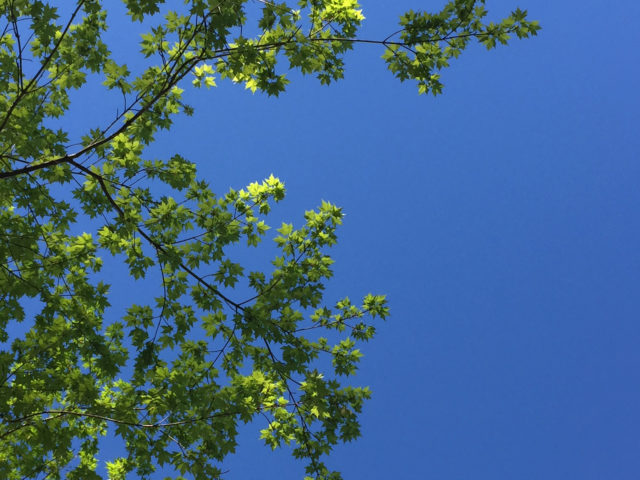“The universe is born every moment through the portal I Am”
Rupert Spira
On summer afternoons when I was a child, I would sit for hours on my Grandma’s patio as we rocked together in our creaky chairs under the shade of the old apple tree. “Grandma, talk to me,” I would say. “Ain’t life grand,” she would begin, a propos of nothing in particular. Then we would talk together for hours while Grandpa tended his flowers and the day softened into evening. I so loved those times as a child. I have virtually no conscious recollection of the details of what we spoke about, but the gift of her attention – of her speaking and listening with that small girl – is buried deep in my bones and in the very physical structure of my brain and mind.
In my psychological studies as an adult, I have come to see how crucial those moments of Grandma’s attention were to the functioning of my brain and to the development of my sense of “myself.” Like all children, my immature brain was often confused and overwhelmed by the chaos of pleasant and unpleasant sense impressions in both my internal and my external worlds. Through those hours with Grandma, as I attuned to her more mature and more coherently organized nervous system, my capacities grew. The very physical structure of my brain required that kind of energy exchange for my billions of neurons to myelinate properly and for them to learn to function together in coherent ways. I developed, literally, through relationship.
Grandma gave me this gift partly through language but also largely through the energetic exchange of our simple presence together. She listened; she saw me. She helped me to  name my experience; she laughed with me and she recognized and responded to my own internal states. I gradually increased my skill at navigating life (mostly) without chaotic overwhelm or extremes of unwholesome behavior. I developed an organized “myself” and an external “other,” each of us with a perceived continuity over time. By my brain’s maturity at around age twenty-five, I was able to think in a coherent way, reflect on my own and others’ experience and have some voluntary control over my behavior. Was I ever lucky to have those precious afternoons under the apple tree with my Grandma!
name my experience; she laughed with me and she recognized and responded to my own internal states. I gradually increased my skill at navigating life (mostly) without chaotic overwhelm or extremes of unwholesome behavior. I developed an organized “myself” and an external “other,” each of us with a perceived continuity over time. By my brain’s maturity at around age twenty-five, I was able to think in a coherent way, reflect on my own and others’ experience and have some voluntary control over my behavior. Was I ever lucky to have those precious afternoons under the apple tree with my Grandma!
As a psychologist, however, I’ve often been confused as I’ve tried to integrate the obvious importance of this developmental process with the Buddha’s teachings on the “emptiness” of the self. How does this all work? I have struggled with this as I’ve explored how to integrate some other, more painful experiences from my growing years. Is my attention to psychological healing as a self somehow in opposition to my spiritual practice?
As far as I know, nowhere in the Buddha’s teachings does he directly address the impact of childhood trauma or the process of healthy or unhealthy child development. In general, his teachings assumed the mature and coherent organization of more or less healthy and mature adult bodies and brains. As he examined the workings of his own mind, however, he saw the continuing of the construction process. He watched directly how the mind relentlessly (re)creates a phenomenological sense of a personal self, one small moment after another: what we take to be “true” about ourselves and others.
Like a good researcher, he carefully observed the limitations of this self-construction. Although I perceive my self as separate and stable, the not-so-obvious reality is that my “self” is never truly separate or – even for the tiniest moment – the same as the moment before. This self is ever new, relentlessly arising and passing away, each moment’s form conditioned by the one(s) that came before. In modern times, even western scientists begin to speak in similar terms. Neuropsychiatrist Daniel Siegel notes that recent understandings suggest that “the idea of a unitary, continuous ‘self’ is actually an illusion our minds attempt to create.”
So, in speaking of “no-self” the Buddha was not saying that my psychological and phenomenological self does not exist. He was not saying that I should disregard care and healing for my physical forms or my psychological wounds or my nourishing relationships. He was saying that all of that does not exist in the way that I usually think that it does; and it never has. He taught that my sense of a constructed self, always partial, always incomplete, always changing, while useful in the short run, is actually something of a dream: unreliable and unworthy of my ultimate allegiance.
In my spiritual practice of “emptiness,” then, I am not suddenly asked to get rid of something solid and real, but rather, I am invited to release my misunderstanding of how “solid” and “real” and “separate” I actually am or can be. He invites me to discover for myself that my human anxieties and discomforts arise from mistakenly imagining myself to be exiled from the basic awareness and goodness that is the ground of all being. He invites me to learn to rest every seeming “thing” in that larger awareness of infinite light, infinite being, infinite love.
I learn it more deeply and again and again. I can never acquire enough: enough sensory pleasure, enough possessions, enough accomplishment, enough recognition, enough safety, for this self to be fully secure and happy. I cannot, even, be “fixed” by spiritual practices: by acquiring the best spiritual teacher or by becoming a perfect meditator or – as the Buddha himself discovered – by the most excellent chants or diets or yoga postures. There will always be endless and fluid uncertainty in all of the forms of this planet.  This aging body, a constant source of challenge, will get sick; both my loved and my hated relationships will grow and change. “I” will ultimately die. It’s just how life is. Happiness, I find, comes not from rejecting my self or my form and its limitations, but rather from learning to release misperceptions, coming to rest – little by little – more at ease in the deeper reality beneath all forms.
This aging body, a constant source of challenge, will get sick; both my loved and my hated relationships will grow and change. “I” will ultimately die. It’s just how life is. Happiness, I find, comes not from rejecting my self or my form and its limitations, but rather from learning to release misperceptions, coming to rest – little by little – more at ease in the deeper reality beneath all forms.
As the Buddha investigated his own heart’s longing for release, he discovered the “middle way.” He taught the freedom, release, joy and profound happiness of letting go, becoming “awake” he said, fully present and fully alive in each fluid moment, just as it is. Being human, I find, cannot be ultimately “fixed” but it can be lived. I can experience its mysteries; I can receive. In moments of releasing identification with the constructions of my mind, I find wisdom, joy, tenderness and compassion. I find more nourishment in shared relationship. I discover wholesome action revealing itself in every moment.
Despite our love for one another, neither Grandma nor I could prevent the sorrows of Grandpa’s death. Nor could we avoid the grief and the painful practical realities of her slow descent into dementia. But each of us – even to the very end – could cultivate and know a deep love and compassion that nourished us both as we shared our journeys. The woman who lived through two world wars and who was affected profoundly by the Great Depression, whose youngest child had become inexplicably disabled, whose life was filled with the joys and sorrows of any human life, could know, could remember, could guide me to know “Ain’t life grand” in every one of its moments.
